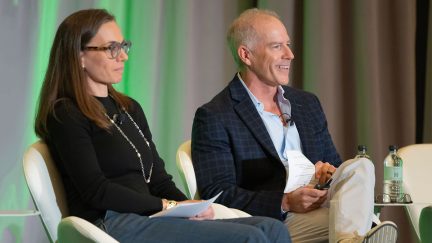For more stories like this, sign up for the PLANADVISERdash daily newsletter.
New WIPN Research Compares ‘Advocates’ and ‘Mentors’

The financial services employment equity advocacy group known as WIPN has published its latest white paper, “The Story of Us: 2021 Evolution of Women in the Retirement Industry,” developed in collaboration with T. Rowe Price and OneDigital Retirement + Wealth.
The publication comes about two months after WIPN’s rebranding, first announced by PLANADVISER Magazine, from the “Women in Pensions Network” to “WE Inspire. Promote. Network.”
The update in vision and mission detailed by WIPN’s leadership with the rebrand clearly rings through in the new research, which dissects the experiences of women—positive and negative—in the financial services space and provides a blueprint for those with power in this industry to address the gender and racial employment gaps that persist.
According to the analysis, the well-documented struggle experienced by professional women trying to find a better work-life balance is prevalent in the retirement planning and financial services industries. WIPN’s analysis shows women in the retirement plan industry experience the same challenges of time, personal workloads and dissatisfaction with the division of labor with their partners as do women in other industries. For context, the survey included some 800 women who are employed in the financial services space.
One in three women places work-life balance as a top factor that makes them feel successful at work—but it’s an area with some of the lowest overall satisfaction in the survey. Fortunately, WIPN finds, women are becoming more inclined to take time out of their schedules to recharge and engage in activities that foster well-being.
Speaking with PLANADVISER about the new report, Jennifer Norr, WIPN’s president and a marketing and strategy executive for CUNA Mutual Retirement Solutions, says one eye-opening finding is that just shy of half of the women in the survey report being the primary wage earner in their family—yet a strong majority of those surveyed also report being more responsible than their spouse for family-related household tasks and caregiving.
“This is just a very telling set of statistics that shows how important caregiving and managing the household is for our respondents,” Norr says. “Fortunately, we do see that 39% often take time for activities to support their well-being, and 85% do this at least sometimes. While time available may be scarce, many women are still finding opportunities for important self-care.”
The survey report says the experience of the coronavirus pandemic has proven that providing remote working options and more schedule flexibility can support caregiving women and help them to excel in their careers, while also allowing them to have more personal time.
“We’ve seen a move toward understanding that doing a good job and being committed is about the output, rather than the amount of time spent sitting in an office,” Norr says. “Stepping back, for women, satisfaction with career performance comes mostly from having a promising career path, more so than reaching the highest possible position. Unfortunately, only half agree that their career path looks promising, representing one of the largest gaps in this research between defining and achieving success.”
The survey shows two in five women have considered leaving their employer over the past year due to a lack of opportunities for advancement, and one in five continue to consider this often. Norr says these statistics should concern all employers.
“Further, one in three respondents don’t believe they have the education and training needed to advance, demonstrating there may be a need for employers to revisit training offerings to employees,” she says. “Employers also need to clearly communicate career paths for all levels to enable upward growth for those who seek it.”
Norr emphasized the importance of the communication aspect of career paths. Simply put, people will not assume they have opportunity to advance, especially over the mid- and long-term, if they are not told so and if they are not given clear guideposts along the journey from employment to promotion to leadership. This is true for everyone, including white men, but it is an especially pernicious problem when considering the outlook of women and people of color. When there is nobody who looks like them at the highest levels of leadership, it is natural for people to question what their own future at any employer looks like, WIPN says.
In terms of actionable takeaways from the research, Norr says there are plenty, but perhaps the most important is the central role of—and the differences between—what WIPN refers to as “mentorship” and “sponsorship.”
“Mentors are like your guru,” Norr says. “They are critical sources of information and inspiration, but they may not be in a position to provide you with direct support in your workplace. A true ‘sponsor’ or ‘advocate’ is someone you can identify and work with on the job, who can and will use their own influence to help someone else succeed in the financial services industry.”
According to the survey data, mentorships and sponsorships are both valuable, but women agree that a sponsor is more likely to help with advancement than a mentor (64% and 47%, respectively). The value of having a mentor or sponsor is recognized by many—as not having one is cited among the top five barriers to success—but only 17% of respondents feel they have a sponsor, though this increases to 42% of women with a mentor.
“The lack of mentors and sponsors is a particular concern among women of color,” Norr notes. “Almost a quarter cite the lack of a mentor/sponsor as a barrier to career growth. Women of color who do not have a mentor say that this is often due to an inability to find one who is a fit. Additionally, the data show that a significantly higher proportion of women of color feel excluded from formal and informal networks at work as compared to white women.”
The analysis goes on to show women of color not only express higher levels of dissatisfaction with their careers, but they also bear the dual burdens of having to “represent” their race and ethnicity and not being able to bring their full selves to work.
“Together, these factors can serve to inhibit career growth and a sense of belonging,” Norr warns. “These sentiments are not just home-spun, but rather stem from the cultures of many workplaces where employers’ actions often do not align to their stated values, even when formal diversity, equity and inclusion efforts exist.”
You Might Also Like:

Rethinking Opportunities for RIA Growth

PE Ownership Expands Into Midsize, Small RIAs

First Half of 2025 Set Record for RIA M&A, per Fidelity
« Excessive Fee Lawsuits Expected to Continue to Rain Down on Plans